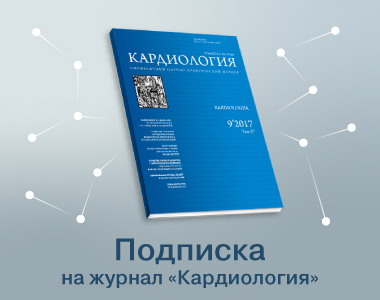External validation of the ORACLE bleeding risk score using the database of the RECORD 3 registry
https://doi.org/10.18087/cardio.2019.12.n677
Abstract
Aim. To validate a domestic scale for assessment risk of bleeding ORACUL (ОРАКУЛ) based on an independent sample of patients with acute coronary syndrome (ACS). Materials and methods. External validation of the ORACUL score was carried out using database of an independent observational study RECORD-3 which comprised data from all patients hospitalized for 1 month (march-april 2015) in 47 centers of 37 cities in 21 regions of Russia. Total number of included patients was 2370, mean age 64.2±11.96 years, 821 patients (34.6%) had ST-elevation, other patients – non-ST elevation ACS. Results. The following bleeding events were registered in RECORD-3: bleedings during hospitalization (n=34, 1.43%), inhospital bleedings requiring withdrawal of antithrombotic treatment (n=16, 0.68%), inhospital bleedings, which required drug or surgical treatment or hemotransfusion (n=16, 0.68%). Forty eight hemorrhagic complications were registered during 6 months of observation after hospital discharge. Diagnostic value of the ORACUL score for estimation of risk of bleedings during index hospitalization was good (C-criterion 0.691±0.050; р<0.001), sensitivity of the model was 58.1%, specificity 79.9%. Earlier on the cohort of patients of the ORACUL study diagnostic value of the score for inhospital bleedings was found to be 0.777±0.046. Difference of diagnostic values was inessential. For estimation of the bleeding risk during 6 months of post discharge observation area under the ROC curve (C-criterion) was 0.628±0.045 (р=0.003), sensitivity and specificity of the model were 53.9 and 73.7%, respectively. On the ORACUL study cohort AUC 0.748±0.048 (р=0.071). Conclusion. External validation confirmed that statistical power of the OCACUL score is sufficient for prediction of bleedings during both periods of hospitalization and after hospital discharge.
About the Authors
L. O. MinushkinaRussian Federation
Minushkina Larisa O. – MD, professor
Moscow
SPIN: 3654-8920
A. D. Erlikh
Russian Federation
Moscow
SPIN: 4697-0822
V. A. Brazhnik
Russian Federation
Moscow
SPIN: 5627-9617
D. A. Zateyshchikov
Russian Federation
Moscow
SPIN-: 1694-3031
References
1. Neumann F-J, Sousa-Uva M, Ahlsson A, Alfonso F, Banning AP, Benedetto U et al. 2018 ESC/EACTS Guidelines on myocardial revascularization. EuroIntervention. 2019;14(14):1435–534. DOI: 10.4244/EIJY19M01_01
2. Roffi M, Patrono C, Collet J-P, Mueller C, Valgimigli M, Andreotti F et al. 2015 ESC Guidelines for the management of acute coronary syndromes in patients presenting without persistent ST-segment elevation: Task Force for the Management of Acute Coronary Syndromes in Patients Presenting without Persistent ST-Segment Elevation of the European Society of Cardiology (ESC). European Heart Journal. 2016;37(3):267–315. DOI: 10.1093/eurheartj/ehv320
3. Subherwal S, Bach RG, Chen AY, Gage BF, Rao SV, Newby LK et al. Baseline Risk of Major Bleeding in Non–ST-Segment–Elevation Myocardial Infarction: The CRUSADE (Can Rapid risk stratification of Unstable angina patients Suppress ADverse outcomes with Early implementation of the ACC/AHA guidelines) Bleeding Score. Circulation. 2009;119(14):1873–82. DOI: 10.1161/CIRCULATIONAHA.108.828541
4. Brazhnik V.A., Minushkina L.O., Guliev R.R., Averkova A.O., Rogozhina A.A., Koroleva O.S. et al. Bleeding risk factors in patients with acute coronary syndrome: data from observational studies ORACUL II. Russian Journal of Cardiology. 2019;24(3):7–16. DOI: 10.15829/1560-4071-2019-3-7-16
5. Erlikh A.D., Gratsiansky N.A. Registry of Acute Coronary Syndromes ‘RECORD-3’. Characteristics of Patients and Treatment During Initial Hospitalization. Kardiologiia. 2016;56(4):16–24. DOI: 10.18565/cardio.2016.4.16–24
6. Mehran R, Rao SV, Bhatt DL, Gibson CM, Caixeta A, Eikelboom J et al. Standardized Bleeding Definitions for Cardiovascular Clinical Trials: A Consensus Report From the Bleeding Academic Research Consortium. Circulation. 2011;123(23):2736–47. DOI: 10.1161/CIRCULATIONAHA.110.009449
7. Averkova A.O., Brazhnik V.A., Koroleva O.S., Zubova E.A., Hasanov N.R., Chichkov Yu.M. et al. Acute coronary syndrome in young patients with familial hyperchoolesterolemia based on the results of Oracul II observation trial. Medical news of the North Caucasus. 2017;12(1):5–8. DOI: 10.14300/mnnc.2017.12001
8. Mathews R, Peterson ED, Chen AY, Wang TY, Chin CT, Fonarow GC et al. In-Hospital Major Bleeding During ST-Elevation and Non–ST-Elevation Myocardial Infarction Care: Derivation and Validation of a Model from the ACTION Registry®-GWTGTM. The American Journal of Cardiology. 2011;107(8):1136–43. DOI: 10.1016/j.amjcard.2010.12.009
9. Mehran R, Pocock SJ, Nikolsky E, Clayton T, Dangas GD, Kirtane AJ et al. A Risk Score to Predict Bleeding in Patients With Acute Coronary Syndromes. Journal of the American College of Cardiology. 2010;55(23):2556–66. DOI: 10.1016/j.jacc.2009.09.076
10. Raposeiras-Roubín S, Faxén J, Íñiguez-Romo A, Henriques JPS, D’Ascenzo F, Saucedo J et al. Development and external validation of a post-discharge bleeding risk score in patients with acute coronary syndrome: The BleeMACS score. International Journal of Cardiology. 2018;254:10–5. DOI: 10.1016/j.ijcard.2017.10.103
11. Baber U, Mehran R, Giustino G, Cohen DJ, Henry TD, Sartori S et al. Coronary Thrombosis and Major Bleeding After PCI With DrugEluting Stents: Risk Scores From PARIS. Journal of the American College of Cardiology. 2016;67(19):2224–34. DOI: 10.1016/j.jacc.2016.02.064
Review
For citations:
Minushkina L.O., Erlikh A.D., Brazhnik V.A., Zateyshchikov D.A. External validation of the ORACLE bleeding risk score using the database of the RECORD 3 registry. Kardiologiia. 2019;59(12):5-10. (In Russ.) https://doi.org/10.18087/cardio.2019.12.n677

















